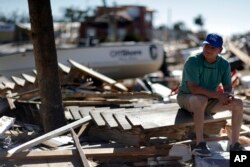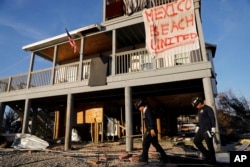The search continued Saturday in Florida for people who may have been killed or trapped by Hurricane Michael, while survivors of the powerful storm sought food, water and other essential goods.
The death toll rose to at least 17 after a body was found Friday in rubble in Mexico Beach, the town where Michael made landfall.
"It's like a war zone," Florida Gov. Rick Scott said as he toured the obliterated community Friday, two days after the Category 4 hurricane made landfall in the Panhandle and churned north through Georgia, the Carolinas and Virginia as a tropical storm.
Scott tweeted Saturday that millions of meals and gallons of water were being delivered to the affected communities.
David Collier, the emergency medical technician battalion chief of Panama City, Fla., which was also devastated by Michael, told CNN on Saturday that food and water distribution stations were being set up.
Emergency officials in Florida said Friday that they had completed an initial "hasty search" for missing people and had begun more thorough searches of thousands of ruined structures. They said they hoped to complete those searches later Saturday.
900,000 customers without power
The Pentagon said 5,000 military personnel were assisting with relief and recovery efforts, using 100 helicopters and 1,800 high-water vehicles.
Nearly 900,000 homes and businesses were still without power Saturday in seven states, officials said.
Florida officials said nearly 300 people in Mexico Beach had ignored mandatory evacuation orders, but it was unclear whether they were able to get out at the last minute.
Federal Emergency Management Agency chief Brock Long said Friday that he expected the death toll to rise."We still haven't gotten into the hardest-hit areas," he said. "Very few people live to tell what it's like to experience storm surge, and unfortunately in this country we seem to not learn the lesson."
Tyndall Air Force Base on the Florida Panhandle suffered so much damage that the 3,600 men and women stationed there, and who were evacuated, were told not to go back.
"I will not recall you and your families until we can guarantee your safety," Colonel Brian Laidlaw said in a statement. He said he did not know how long recovery efforts would take because "we need to restore basic utilities, clear our roads of trees and power lines, and assess the structural integrity of our buildings."
Residents and rescue workers in Florida and other southeastern U.S. states continued to dig through the devastation inflicted the hurricane, the remnants of which moved out into the Atlantic Ocean before it dissipated.
U.S. President Trump has declared states of emergency in Florida and Alabama, freeing up federal assistance for disaster relief efforts.
The storm was the strongest on record to hit the Florida Panhandle and the third most powerful to strike the U.S. mainland.
Large areas of the coast of the Panhandle, including Mexico Beach and Panama City, were left in ruins. The area is home to a number of rural communities that are among the poorest in the state.
In Mexico Beach, entire blocks of houses were razed, boats hurled into yards and the streets cluttered with downed power lines and trees.
Michael made landfall with maximum sustained winds of 249 kph (155 mph), putting it just below the Category 5 status that tops the scale used to describe the strength and destructive potential of hurricanes.
The Atlantic hurricane season began in June and ends Nov. 30.










